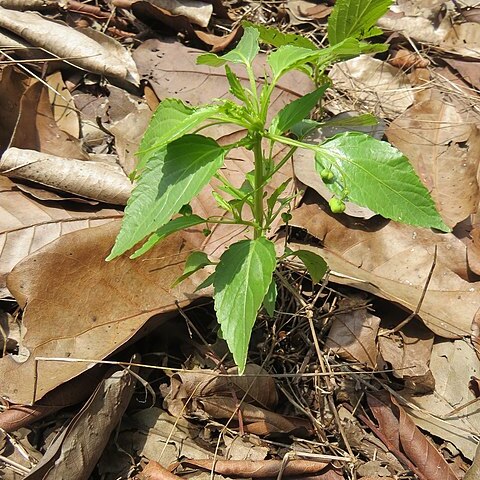Herb to 40 cm high. Stipules triangular, c. 0.5 mm long. Leaves: petiole 3–40 mm long; lamina elliptic, lanceolate-ovate or ovate, 10–60 mm long, 5–30 mm wide; base cuneate to rounded; margins crenate with 28–36 teeth per leaf; tip acute to acuminate; lateral veins 4–7 per side of midrib. Male flowers: pedicels 0.5–0.8 mm long; calyx lobes elliptic-obovate to ovate, 0.5–0.8 mm long, 0.4–0.5 mm wide; stamens 6–10, filaments 0.3–0.5 mm long, anthers c. 0.2 mm long, 0.2 mm wide. Female flowers: pedicels 1–2 mm long; calyx lobes 3–5, lanceolate to lanceolate-ovate, 1–2 mm long, 0.8–1 mm wide; styles 0.5–1 mm long. Fruit 2–2.5 mm long, 3–4 mm diam. Seeds 1.8–2 mm long, 1.5–1.7 mm wide, brown.
An annual herb. The lower parts become woody. It grows 60 cm tall. The leaves are alternate. The leaf stalk is 3.5 cm long. The leaf blades are narrowly oval and 2-8 cm long by 1-4 cm wide. They taper to the tip. The edges are wavy. They are dull grey-green. The flowers are in groups 3-12 cm long. The flowers are in clusters along this. They are in groups with one female flower and several male flowers. The fruit is a flattened 3 lobed capsule. It is 3 mm long by 4 mm wide and purplish. The seeds are angular.
Female flowers: pedicels 1–5 mm long, extending to 3 cm in fruit, pubescent; sepals 1–2 mm long, ovate-lanceolate, acute, sparingly pubescent, green with a narrow hyaline margin; disk glands 1 mm long, linear-filiform; ovary 1 mm in diameter, 2-lobed to 4-lobed, minutely papillose, strigose, purple; styles 1 mm long, glabrous, ochreous-tawny.
Male flowers: pedicels 2 mm long, capillary, glabrous; calyx lobes 0.75 mm long, obovate-suborbicular, ± glabrous, pale yellowish-green or whitish; disk glands spathulate, pubescent, purple; stamens 3–20, 1–multiseriate, filaments 0.5 mm long, purple, anthers minute, yellow.
Leaf blades 2–7 × 1–3.5 cm, elliptic-ovate, subacute or obtuse apically, crenate, ± rounded at the base, membranaceous, sparingly pubescent to subglabrous, punctate, dull, pale green, sometimes purplish-tinged; lateral nerves in 4–7 pairs, ascending, camptodromous.
Fruit 2–3 × 3.5–5.5 mm, roundly 3-lobed, rarely 2-or 4-lobed, sparingly strigose to subglabrous, dark green or bluish-green becoming dull purple on drying; columella 1.5 mm long.
Inflorescences 1–7.5 cm long, usually bisexual; bracts c. 1 mm long, ovate-lanceolate, green with hyaline margins.
Seeds 2 × 1.5 mm, ovoid-subglobose, reticulate, reddish-brown, greyish or blackish, paler in the pits.
A weed of cultivation, 1/2–2 ft. high, stems simple or branched, pubescent, woody below.
An erect or procumbent annual herb up to 50 cm tall, rarely taller.
Stipules 0.5 mm long, glandular.
Stems crisped-pubescent in rows.
Stipels minute, glandular.
Petioles 0.5–2.5 cm long.

